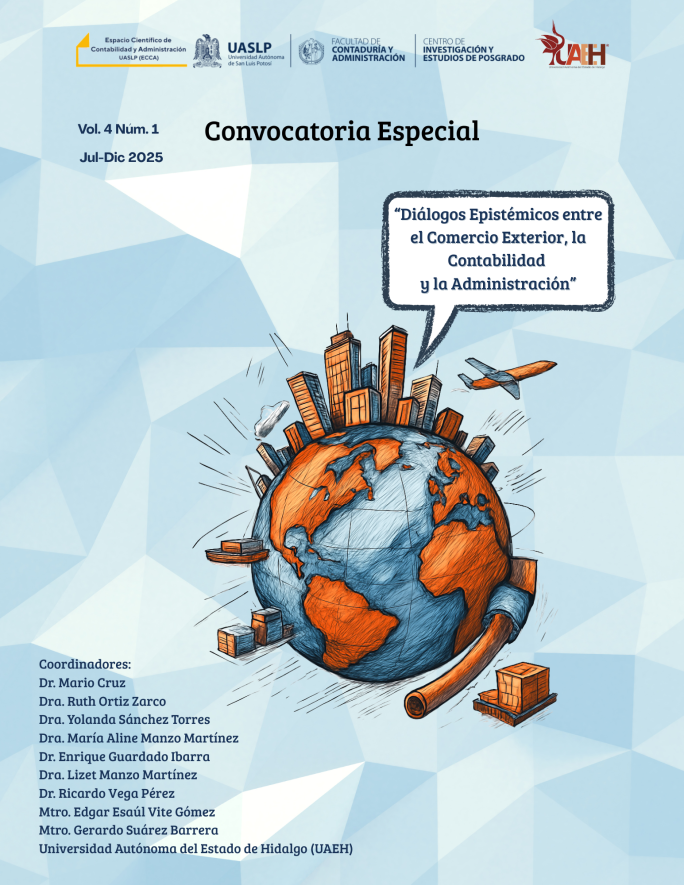El capital social e innovación social: propulsores de la sustentabilidad
DOI:
https://doi.org/10.58493/ecca.2024.3.1.01Palabras clave:
Capital social, Innovación Social, Sustentabilidad, Biliometrico, Revisión Sistemática de LiteraturaResumen
Este artículo presenta un análisis bibliométrico en conjunto con una revisión de literatura con el fin de poder presentar un modelo conceptual que ayude en establecer una relación entre el capital social y la innovación social como generadores de sustentabilidad. Esta investigación, además toma en cuenta temas de tendencia actual como lo es la innovación social en la búsqueda de alcanzar la sustentabilidad desde un enfoque económico. En la parte metodológica de este estudio, se inició desde un análisis bibliométrico para poder conocer primeramente cómo es que estos temas han evolucionado a través del tiempo y posteriormente se realizó una revisión de literatura sistemática a través de seis pasos para poder determinar los artículos empíricos que ayudarían con la justificación del modelo conceptual que aquí se presenta.
Citas
Adi, S., Irawan, B., Suroso, I., & Sudaryanto, S. (2022). Loyalty-Based Sustainable Competitive Advantage and Intention to Choose Back at One Bank. Quality - Access to Success, 23(189). https://doi.org/10.47750/QAS/23.189.35
Aidara, S., Al-Mamun, A., Md-Nasir, N. A., & Mohiuddin, M. (2022). Sustainability performance of informal micro-enterprises: The case of Senegal. Journal of Developmental Entrepreneurship, 27(01). https://doi.org/10.1142/S1084946722500017
Alfalih, A. A. (2022). The Role of Sustainable Entrepreneurship and Corporate Social Performance on Social Innovation: the Case of the Private Industrial Sector in Saudi Arabia. Journal of the Knowledge Economy, 13(3), 1928–1943. https://doi.org/10.1007/s13132-021-00798-7
Al-Omoush, K. S., Ribeiro-Navarrete, S., Lassala, C., & Skare, M. (2022). Networking and knowledge creation: Social capital and collaborative innovation in responding to the COVID-19 crisis. Journal of Innovation & Knowledge, 7(2), 100181. https://doi.org/10.1016/j.jik.2022.100181
Aria, M., & Cuccurullo, C. (2017). bibliometrix : An R-tool for comprehensive science mapping analysis. Journal of Informetrics, 11(4), 959–975. https://doi.org/10.1016/j.joi.2017.08.007
Artaraz, M. (2002). Teoría de las tres dimensiones de desarrollo sostenible. Ecosistemas, 11(2). https://www.revistaecosistemas.net/index.php/ecosistemas/article/view/614
Bernardes, E. S. (2010). The effect of supply management on aspects of social capital and the impact on performance: A social network perspective. Journal of Supply Chain Management, 46(1), 45–55. https://doi.org/10.1111/j.1745-493X.2009.03185.x
Bizarrias, F. S., Cucato, J. S. T., Strehlau, V. I., Takahashi, C. K., & Gonçalves, R. B. (2022). Compreendendo perfis de preferência por produtos sustentáveis: a influência condicional do ceticismo a partir do capital social. ReMark - Revista Brasileira de Marketing, 21(2), 292–366. https://doi.org/10.5585/remark.v21i2.19759
Blázquez, M., & Peretti, M. F. (2012). Modelo para gestionar la sustentabilidad de las organizaciones a través de la rentabilidad, adaptabilidad e imagen. Estudios Gerenciales, 28(125), 40–50. https://www.redalyc.org/articulo.oa?id=21226279005
Bolino, M. C., Turnley, W. H., & Bloodgood, J. M. (2002). Citizenship Behavior and the Creation of Social Capital in Organizations. The Academy of Management Review, 27(4), 505. https://doi.org/10.2307/4134400
Bourdieu, P. (1977). The economics of linguistic exchanges. Social Science Information, 16(6), 645–668. https://doi.org/10.1177/053901847701600601
Brundtland, G. H. (1987). “Our common Future.”
Carberry, E. J., Bharati, P., Levy, D. L., & Chaudhury, A. (2019). Social Movements as Catalysts for Corporate Social Innovation: Environmental Activism and the Adoption of Green Information Systems. Business & Society, 58(5), 1083–1127. https://doi.org/10.1177/0007650317701674
Castilla-Polo, F., & Sánchez-Hernández, M. I. (2022). International orientation: An antecedent-consequence model in Spanish agri-food cooperatives which are aware of the circular economy. Journal of Business Research, 152, 231–241. https://doi.org/10.1016/j.jbusres.2022.07.038
Caulier-Grice, J. A., Davies, R. P., & Norman, W. (2012). Defining Social Innovation. Part one of Social Innovation Overview: The theoretical, empirical and policy foundations for building social innovation in Europe (TEPSIE). European Commission – 7th Framework Programme, Brussels: European Commission, DG.
Cavazos-Arroyo, J., Puente-Díaz, R., & Agarwal, N. (2017). An examination of certain antecedents of social entrepreneurial intentions among Mexico residentes. Review of Business Management, 19(64), 180–218. https://doi.org/10.7819/rbgn.v19i64.3129
Cegarra-Navarro, J.-G., Reverte, C., Gómez-Melero, E., & Wensley, A. K. P. (2016). Linking social and economic responsibilities with financial performance: The role of innovation. European Management Journal, 34(5), 530–539. https://doi.org/10.1016/j.emj.2016.02.006
Chen, P.-C., & Hung, S.-W. (2014). Collaborative green innovation in emerging countries: a social capital perspective. International Journal of Operations & Production Management, 34(3), 347–363. https://doi.org/10.1108/IJOPM-06-2012-0222
Coleman, J. S. (1988). Social Capital in the Creation of Human Capital. American Journal of Sociology, 94, S95–S120. https://doi.org/10.1086/228943
Comisión Económica Para América Latina y El Caribe (CEPAL). (2008). Claves de la innovación social en América Latina y el Caribe, Naciones Unidas, Santiago de Chile. In Comisión Económica para Amércia Latina y el Caribe (CEPAL) (Vols. 2004–1). https://repositorio.cepal.org/handle/11362/2536%0Ahttp://ulegid.unileon.es/admin/UploadFolder/63_(2004).pdf%5Cn
Danes, S. M., Stafford, K., Haynes, G., & Amarapurkar, S. S. (2009). Family Capital of Family Firms. Family Business Review, 22(3), 199–215. https://doi.org/10.1177/0894486509333424
De Clercq, D., Thongpapanl, N. (Tek), & Voronov, M. (2015). Explaining SME engagement in local sourcing: The roles of location-specific resources and patriotism. International Small Business Journal: Researching Entrepreneurship, 33(8), 929–950. https://doi.org/10.1177/0266242614540316
DeFillippi, R. J., & Arthur, M. B. (1998). Paradox in Project-Based Enterprise: The Case of Film Making. California Management Review, 40(2), 125–139. https://doi.org/10.2307/41165936
Díaz-Perdomo, Y., Álvarez-González, L. I., & Sanzo-Pérez, M. J. (2021). A Way to Boost the Impact of Business on 2030 United Nations Sustainable Development Goals: Co-creation With Non-profits for Social Innovation. Frontiers in Psychology, 12. https://doi.org/10.3389/fpsyg.2021.719907
Edwards, M., & Onyx, J. (2007). Social Capital and Sustainability in a Community under Threat. Local Environment, 12(1), 17–30. https://doi.org/10.1080/13549830601098206
Feroz, A. K., Zo, H., & Chiravuri, A. (2021). Digital Transformation and Environmental Sustainability: A Review and Research Agenda. Sustainability, 13(3), 1530. https://doi.org/10.3390/su13031530
Garrigos-Simon, F., Botella-Carrubi, M., & Gonzalez-Cruz, T. (2018). Social Capital, Human Capital, and Sustainability: A Bibliometric and Visualization Analysis. Sustainability, 10(12), 4751. https://doi.org/10.3390/su10124751
Hernández Arteaga, I., Pérez Muñoz, C., & Rua Castañeda, S. (2018). Intereses y perspectivas formativas en economía social y solidaria de los estudiantes universitarios. CIRIEC-España, Revista de Economía Pública, Social y Cooperativa, 94, 91. https://doi.org/10.7203/CIRIEC-E.94.12782
Howaldt, J., & Schwarz, M. (2010). Soziale Innovation – Konzepte, Forschungsfelder und -perspektiven. Soziale Innovation, 87–108. https://doi.org/10.1007/978-3-531-92469-4_5
Kanter R. M. (1999). From spare change to real change. The social sector as beta site for business innovation. Harvard Business Review, 77(3), 122–210.
Kim, E., & Yoon, S. (2021). Social capital, user motivation, and collaborative consumption of online platform services. Journal of Retailing and Consumer Services, 62, 102651. https://doi.org/10.1016/j.jretconser.2021.102651
Kim, J. (2018). Social dimension of sustainability: From community to social capital. Journal of Global Scholars of Marketing Science, 28(2), 175–181. https://doi.org/10.1080/21639159.2018.1436982
Kim, J., Kang, S., & Lee, K. H. (2020). How social capital impacts the purchase intention of sustainable fashion products. Journal of Business Research, 117, 596–603. https://doi.org/10.1016/j.jbusres.2018.10.010
Lombardi, M., Lopolito, A., Andriano, A. M., Prosperi, M., Stasi, A., & Iannuzzi, E. (2020). NETWORK IMPACT OF SOCIAL INNOVATION INITIATIVES IN MARGINALISED RURAL COMMUNITIES. Social Networks, 63, 11–20. https://doi.org/10.1016/j.socnet.2020.04.001
Maak, T., Pless, N. M., & Voegtlin, C. (2016). Business Statesman or Shareholder Advocate? CEO Responsible Leadership Styles and the Micro‐Foundations of Political CSR. Journal of Management Studies, 53(3), 463–493. https://doi.org/10.1111/joms.12195
Mirvis, P., Herrera, M. E. B., Googins, B., & Albareda, L. (2016). Corporate social innovation: How firms learn to innovate for the greater good. Journal of Business Research, 69(11), 5014–5021. https://doi.org/10.1016/j.jbusres.2016.04.073
Mishchuk, H., Bilan, Y., Androniceanu, A., & Krol, V. (2023). Social capital: Evaluating its roles in competitiveness and ensuring human development. Journal of Competitiveness, 15(2). https://doi.org/10.7441/joc.2023.02.01
Moulaert, F., MacCallum, D., Mehmood, A., & Hamdouch, A. (2014). The international handbook on social innovation: collective action, social learning and transdisciplinary research. https://www.e-elgar.com/shop/gbp/the-international-handbook-on-social-innovation-9781782545590.html
Mulgan, Geoff., Tucker, Simon., Ali, Rushanara., Sanders, Ben., & University of Oxford. Skoll Centre for Social Entrepreneurship. (2007). Social Innovation: what it is, why it matters, how it can be accelerated. https://ictlogy.net/bibliography/reports/projects.php?idp=4189
Nesta (National Endowment for Science, T. and the A. (2008). Social Innovation: New approaches to transforming public services. www.nesta.org.uk/programmes/
Nugraha, A. T., Prayitno, G., Azizi, F. A., Sari, N., Hidayana, I. I., Auliah, A., & Siankwilimba, E. (2023). Structural Equation Model (SEM) of Social Capital with Landowner Intention. Economies, 11(4), 127. https://doi.org/10.3390/economies11040127
Oliver, C. (1996). The Institutional Embeddedness of Economic Activity. Advances in Strategic Management , 13, 163–186.
Palafox-Muñoz, A., & Arroyo-Delgado, M. V. (2020). Gobernanza y sustentabilidad social a través del turismo en el Área Natural Protegida de Cabo Pulmo, Baja California Sur, México. Apuntes: Revista de Ciencias Sociales, 47(87), 119–147. https://doi.org/10.21678/apuntes.87.1056
Patias, T. Z., Liszbinski, B. B., Gomes, C. M., Brizolla, M. M. B., & Baggio, D. K. (2021). INOVAÇÃO SOCIAL E SUSTENTABILIDADE EM AGROINDÚSTRIAS FAMILIARES. Revista Eletrônica de Estratégia & Negócios, 14(2), 53. https://doi.org/10.19177/reen.v14e2202153-82
Peng, X.-E., & Liang, C. (2019). Before Nonprofit Organisations Become Social Enterprises. VOLUNTAS: International Journal of Voluntary and Nonprofit Organizations, 30(3), 460–474. https://doi.org/10.1007/s11266-018-00071-7
Phong Nguyen, N., Adomako, S., & Ahsan, M. (2023). The base-of- the-pyramid orientation and export performance of Vietnamese small and medium enterprises. Journal of Business Research, 154, 113314. https://doi.org/10.1016/j.jbusres.2022.113314
Plascencia, J. (2005). Tres visiones sobre capital social: Bourdieu, Coleman y Putnam. Acta Republicana: Política y Sociedad, Vol.4 No.4, 21–36.
Putnam, R. (1993). The prosperous community: Social capital and public life. . The American Prospect, 13(4), 35–42.
Putnam, R. D. (1993). The prosperous community social capital and public life. http://www.philia.ca/files/pdf/ProsperousCommunity.pdf
Rogers, S., Gardner, K., & Carlson, C. (2013). Social Capital and Walkability as Social Aspects of Sustainability. Sustainability, 5(8), 3473–3483. https://doi.org/10.3390/su5083473
Sabatini, F. (2008). Social Capital and the Quality of Economic Development. Kyklos, 61(3), 466–499. https://doi.org/10.1111/j.1467-6435.2008.00413.x
Sanzo-Perez, M. J., Álvarez-González, L. I., & Rey-García, M. (2015). How to encourage social innovations: a resource-based approach. The Service Industries Journal, 35(7–8), 430–447. https://doi.org/10.1080/02642069.2015.1015517
Schumpeter, J. (1934). The Theory of Economic Development. In Harvard University Press (Ed.), Cambridge, MA. First Published in 1911; republished 1968.
Souza, A. C. A. A. de, Lessa, B. de S., & Lázaro da Silva Filho, J. C. (2019). Social innovation and the promotion of local economic development. Innovation & Management Review, 16(1), 55–71. https://doi.org/10.1108/INMR-10-2018-0074
Theodoraki, C., Messeghem, K., & Rice, M. P. (2018). A social capital approach to the development of sustainable entrepreneurial ecosystems: an explorative study. Small Business Economics, 51(1), 153–170. https://doi.org/10.1007/s11187-017-9924-0
Ting, S. H., Yahya, S., & Tan, C. L. (2019). The influence of researcher competence on university-industry collaboration. Journal of Entrepreneurship in Emerging Economies, 11(2), 277–303. https://doi.org/10.1108/JEEE-06-2018-0054
Tipu, S. A. A., & Fantazy, K. (2018). Exploring the relationships of strategic entrepreneurship and social capital to sustainable supply chain management and organizational performance. International Journal of Productivity and Performance Management, 67(9), 2046–2070. https://doi.org/10.1108/IJPPM-04-2017-0084
Ureña Espaillat, H. J., Briones Peñalver, A. J., & Bernal Conesa, J. A. (2022). La creatividad en entidades de la Economía Social: una visión desde casos múltiples y una metodología mixta. CIRIEC-España, Revista de Economía Pública, Social y Cooperativa, 104, 83. https://doi.org/10.7203/CIRIEC-E.104.21721
van der Have, R. P., & Rubalcaba, L. (2016). Social innovation research: An emerging area of innovation studies? Research Policy, 45(9), 1923–1935. https://doi.org/10.1016/j.respol.2016.06.010
Vercher, N., Bosworth, G., & Esparcia, J. (2023). Developing a framework for radical and incremental social innovation in rural areas. Journal of Rural Studies, 99, 233–242. https://doi.org/10.1016/j.jrurstud.2022.01.007
Wibowo, M. A., & Widodo. (2022). The Approach of Social Innovation Agility: A Dynamic Capability Strategy. Quality - Access to Success, 23(188). https://doi.org/10.47750/QAS/23.188.01
Wu, R., Huo, B., Yu, Y., & Zhang, Z. (2022). Quality and green management for operational and environmental performance: relational capital in supply chain management. International Journal of Logistics Research and Applications, 25(4–5), 471–492. https://doi.org/10.1080/13675567.2020.1836138
Xie, X., Hoang, T. T., & Zhu, Q. (2022). Green process innovation and financial performance: The role of green social capital and customers’ tacit green needs. Journal of Innovation & Knowledge, 7(1), 100165. https://doi.org/10.1016/j.jik.2022.100165
Yu, L., & Nilsson, J. (2019). Social Capital and Financial Capital in Chinese Cooperatives. Sustainability, 11(8), 2415. https://doi.org/10.3390/su11082415
Zarta-Ávila, P. (2018). La sustentabilidad o sostenibilidad: un concepto poderoso para la humanidad. Tabula Rasa, 28, 409–423. https://doi.org/10.25058/20112742.n28.18
Zhang, M., Zeng, W., Tse, Y. K., Wang, Y., & Smart, P. (2021). Examining the antecedents and consequences of green product innovation. Industrial Marketing Management, 93, 413–427. https://doi.org/10.1016/j.indmarman.2020.03.028
Zuckerman, S. J. (2020). “Why can’t this work here?”: social innovation and collective impact in a micropolitan community. Community Development, 51(4), 401–419. https://doi.org/10.1080/15575330.2020.1789183
Zürn, M. (2020). Unknown effects of social innovations. International Theory, 12(3), 471–480. https://doi.org/10.1017/S1752971920000251

Descargas
Publicado
Número
Sección
Licencia
Derechos de autor 2025 José Francisco Zuñiga Ortega

Esta obra está bajo una licencia internacional Creative Commons Atribución-NoComercial-CompartirIgual 4.0.
Usted es libre de:
- Compartir — copiar y redistribuir el material en cualquier medio o formato
- Adaptar — remezclar, transformar y construir a partir del material
- La licenciante no puede revocar estas libertades en tanto usted siga los términos de la licencia
Bajo los siguientes términos:
- Atribución — Usted debe dar crédito de manera adecuada , brindar un enlace a la licencia, e indicar si se han realizado cambios . Puede hacerlo en cualquier forma razonable, pero no de forma tal que sugiera que usted o su uso tienen el apoyo de la licenciante.
- NoComercial — Usted no puede hacer uso del material con propósitos comerciales .
- CompartirIgual — Si remezcla, transforma o crea a partir del material, debe distribuir su contribución bajo la la misma licencia del original.
- No hay restricciones adicionales — No puede aplicar términos legales ni medidas tecnológicas que restrinjan legalmente a otras a hacer cualquier uso permitido por la licencia.











